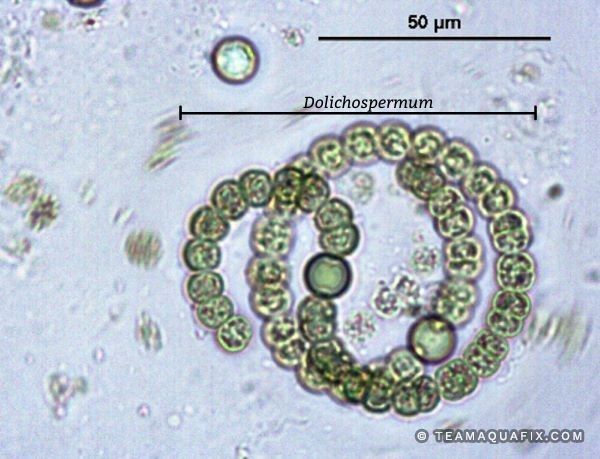
Dolichospermum can cause high effluent TSS and generate toxins within the lagoon and effluent.
If Dolichospermum growth is suspected taking precautions such as wearing a mask and gloves to avoid skin contact is recommended.
There are many ways to treat Dolichospermum. We recommend adding Argos, a chelated copper algaecide. Argos will damage the cells, causing them to leak and die. AquaSticker can speed the treatment process by disrupting the microbiota of this algae which weakens it, allowing the Argos easier access to the cells. In situations with high levels of soluble reactive phosphorus, binders such as alum or aluminum chlorohydrate may help to precipitate some of this phosphorus out of the water column. Sludge can be physically removed by dredging or a non-disruptive option: SludgeRx. This can aid in sludge reduction and prevent the resuspension of nutrients, such as nitrogen and phosphorus.
Because wastewater issues and the cause behind algae can be complex, we recommend our Filament ID and Microanalysis. This not only confirms algae and filament ID, but looks at biological indicators, plant design, and incoming substrates to decode your unique process.
The floating planktonic forms of Anabaena are now classified as Dolichospermum, while its benthic forms are still referred to as Anabaena. Dolichospermum, is a filamentous, blue-green cyanobacterium with bead or barrel-shaped cells. Dolichospermum can form a thick “green paint” scum on lagoon surfaces with low water movement. If scum is present it can be an indication of insufficient aeration. The presence of Dolichospermum in a wastewater lagoon is typically a symptom of an inefficient treatment process. This may occur due to the overloading of organics into lagoon systems as it is rare to see this alga in typical aeration basins/typical lagoon systems with normal BOD loading rates.
Dolichospermum can form gelatinous masses which can produce toxins. This alga is typically found in late spring to autumn, free-floating in slow-flowing or still water columns. The typical cause of this alga is high levels of soluble phosphorus. This may be caused in lagoons with low dissolved oxygen. Dolichospermum has special cells within the filaments call heterocytes that can help this alga with nitrogen fixation that converts atmospheric nitrogen to ammonia. This fixed nitrogen is distributed from the heterocyte throughout the filament.
Encyclopedia Britannica. (2016). Anabaena. Britannica. https://www.britannica.com/science/Anabaena
Environmental Protection Agency. (n.d.). Learn about cyanobacteria and cyanotoxins. EPA. https://www.epa.gov/cyanohabs/learn-about-cyanobacteria-and-cyanotoxins

39041 RGE RD 283,
Red Deer County, AB T4E 0M2
Phone: 1-888-466-0031 |
Fax: 1-888-507-9716
To place an order, please fill out the required fields below and proceed to checkout. Ensure all information is accurate, and feel free to contact our support team if you have any questions or need assistance. Thank you for choosing us!